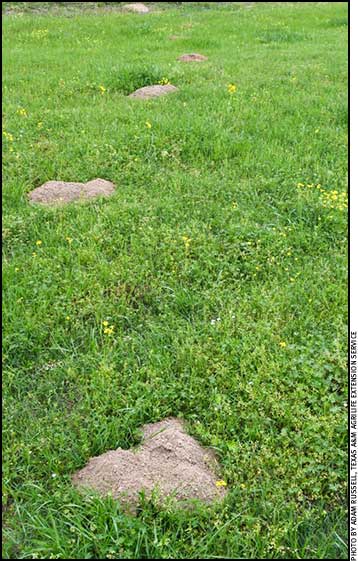Gopher Control Tricky, Worth Effort
Hay and livestock producers take control of gopher issues.

A series of gopher mounds in an East Texas pasture. Gophers consume vegetation and plant roots while mounds can cause damage to farm equipment.
Gophers can be a nuisance to hay and livestock producers, and springtime is a good time to address them, said a Texas A&M AgriLife Extension Service expert.
Gopher burrowing can cause damage to equipment and livestock injuries, said Vanessa Corriher-Olson, AgriLife Extension forage specialist, Overton. The rodents also can damage crops by covering available forage and by consuming plant roots and vegetation.
“We see more gophers in the sandy soils of East Texas,” she said. “The soil is easier to burrow and build mounds and tunnel systems. Gophers can cause significant issues in a pasture if they’re not controlled. Their mounds can be rough on equipment.”
Gophers spend mostly solitary lives below ground. A single gopher can burrow a tunnel system that extends as long as 800 feet, covers an acre and ranges in depth from a few inches to several feet, according to AgriLife Extension.
Corriher-Olson said most producers view them as pests and choose eradication measures to control them.
Control operations should be conducted during the spring and fall when gophers are most active near the surface, according to AgriLife Extension.
The strategies to address gophers in hay pastures differ slightly from control methods around a home because of the size and scale of the area to cover, Corriher-Olson said.
Homeowners can employ a variety of methods, including trapping and pesticide. Pesticide is the most effective method when it comes to treating pastures effectively, she said.
“Most producers will use a Diphacinone-based product,” she said. “Products are usually treated grain or sorghum.”
There are various methods to apply the pesticide, Corriher-Olson said. No Texas Department of Agriculture pesticide applicator license is required to utilize products on gophers, but users should be mindful to keep the product away from other wildlife and grazing livestock.
“The product needs to be placed in the tunnel system for effectiveness and to prevent birds, pets and other animals from consuming the product,” she said.
Bait-injection equipment, such as a burrow builder, can mechanically apply the product. Some pesticide retailers have equipment available to rent. Manual injection equipment can also place bait in tunnels.
Applicators should find the newest mound or series of mounds in the burrow, according to AgriLife Extension. Locate the main runway by probing the soil with a bluntly pointed probe, such as a piece of rebar or dowel rod, 6 inches (in.)-8 in. from the mound on the side where a horseshoe-like depression is found.
After locating the main runway, remove the probe and insert the recommended doses of bait. Close the opening with grass or paper and cover with dirt to keep out light and air, as well as to avoid covering the bait with soil. Place the bait near each end of the main runway and at one or more locations in the central part of the tunnel system.
Burrow builders create artificial burrows and dispense bait underground. It can be pulled back and forth across a field to make a series of parallel burrows. Gophers will explore the artificial burrow and find the bait. The soil must have adequate moisture for plowing and to effectively construct burrows.
“Dealing with gophers can be tricky,” Corriher-Olson said. “They rarely are seen, but mounds and tunnels are a good indication of their presence. They are a pest that could take some persistence and multiple applications in different locations to be controlled successfully.”

Editor’s Note: Adam Russell is a communications specialist with Texas AgriLife Extension Communications.






